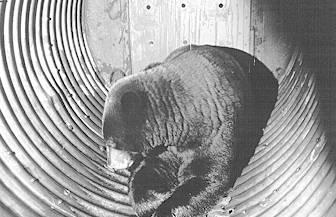People and bears
- by Michael Morris, Mount Revelstoke and Glacier National Parks
- July 24, 2002
The only time that grizzly bears lose their normal behaviour of avoiding people is when food is involved. Human foods are highly attractive for these curious and intelligent animals. Once they learn a food source they never forget it. We leave behind garbage, fruit tree windfalls, hunting gut piles, picnic baskets, all of which can attract bears. Unfenced garbage dumps in particular cause high bear mortality. Intolerance of grizzly bears near communities results in an average of 49 bears per year being destroyed by BC Conservation Officers and persons concerned for their safety or property. Many more kills go unreported.

Keeping food attractants unavailable to bears helps keeps bears out of trouble. Store garbage cans indoors until garbage day. Parks Canada, Mas Matsushita photo.
For black bears, the most common urban attractants are garbage, compost, fruit trees, animal feeds, and barbecues. In more rural settings agricultural fruit crops, grain spills from rail cars, livestock, and bee hives are the common attractants that bring bears into close contact with people. They condition bears to forage near our residences and create circumstances whereby bears damage property and ultimately result in the bear’s destruction. Human carelessness results in food-conditioned bears. Over the past decade Conservation Officers in BC disposed of an average of 1180 black bears per year because of a perceived threat from these nuisance bears.
Capturing and relocating problem bears is difficult, expensive and stressful for all concerned. Captured bears are routinely destroyed. Some relocation effort has been invested in grizzly bears because they are a recognized threatened species. Starting in 1994, nine female grizzly bears, captured by the Provincial Conservation Officer Service in human-bear conflict situations, were radio-collared and moved distances ranging from 43 km to 200 km away from their capture site. The Upper Columbia Bear Research Project (UCBRP) then tracked these bears for up to seven years. At the same time, the UCBRP followed a sample of 18 wild female grizzlies.
Two of the nine problem bears returned to their original capture location – the two that had been moved the shortest distances. Both returning bears became problems a second time. Two of the seven non-returning bears became problems in their new homes.

The outcome is seldom good for problem bears captured in a culvert trap. Parks Canada, Mas Matsushita photo.
Most of the relocated bears wandered widely and erratically compared to the wild bears. The average home range size of a translocated bear was 1053 km2, almost eight times the home range size of a wild bear (143 km2). They wandered so widely, it was difficult for field technicians to find these radio collared bears from week to week.
In recent years in Revelstoke, Golden and other BC communities, a citizen based education program “Bear Awareness” has greatly reduced local bear mortality. If you live in a community or acreage near bear habitat, make sure you are not attracting bears to your home, placing bears, your family and your neighbours at risk.
How to keep from creating a problem bear
- Keep garbage in a secured building until pick-up day.
- Keep dog food, fish or meat remains indoors.
- Pick fruit as it ripens and clean up windfalls promptly.
- Clean barbecue grills or store them inside.
- Consider electric fences or simply eliminating bee hives, chicken coups, or compost piles if they are a continuing attractant.
If you camp in bear habitat, consider the following:
- Choose a campsite that is off a natural travel corridor. Bears will use a path of least resistance.
- Plan to cook well away from your tent so if a bear does come by later to check out the inevitable cooking spills, you won’t be there.
- Choose to bring along simple to prepare foods that have little scent, like oatmeal instead of bacon for breakfast. Keep food out of the tent.
- Carry 15 metres of rope for hanging food. Remember black bears climb trees well, so hang it off a branch out of reach. Where there are only very small trees such as subalpine areas, stash your food away from camp.
- Avoid campsites where litter is present. This could be a mess left by a bear who has learned to associate people with food.
For more information, visit:
Revelstoke Bear Aware http://www.revelstokebearaware.org/
BC Conservation Foundation Bear Aware Program http://www.bearaware.bc.ca

